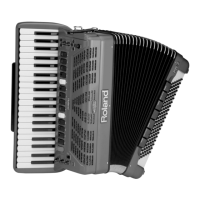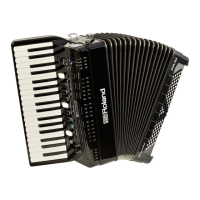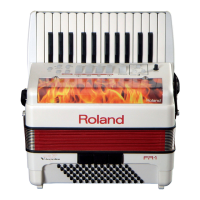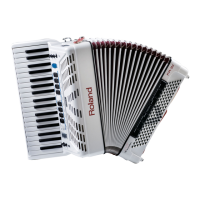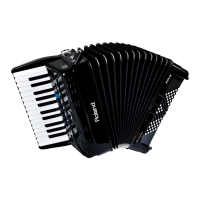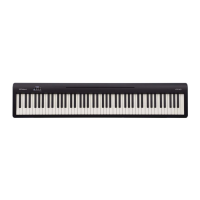Menu Options
72
Parameter Value Explanation
MUSETTE
DETUNE
O, Dry, Classic,
F-Folk, American_L,
American_H,
North_Eu, German_L,
D Folk_L, Italian_L,
German_H, Alpine,
Italian_H, D-Folk_H,
French, Scottish
This parameter allows you to choose
the system used for detuning the
8’ reeds. See “Musette Detune” (p.
40) for details.
2.2 Register
The parameters on this page are used in
combination with the settings above. Here, you
decide which feet should be audible and how they
should be played. It is therefore on this page that
you specify whether the sounds you selected
above will indeed be used.
Parameter Value Explanation
FOOT
All, 16’, 8’, 8’–, 8’+, 4’,
5-1/3’, 2-2/3’
Chose the reed you wish to edit.
STATUS O, On, CASS
• “O”: No sound
• “On”: Sound
• “CASS”: On-Cassotto (mued
sound)
OCTAVE -1~0~+1
This parameter allows you to transpose
the selected register one octave up or
down.
This can be used for two purposes:
• to quickly correct the pitch that
results from the active reeds (see
above) –or–
• to avoid overlaps of the selected
register when using an ORCHESTRA
sound. (The ORCHESTRA
section also provides an “Octave”
parameter.)
LEVEL O, –40~Std~+40
This parameter can be set for each
reed/footage individually. It allows you
to create the desired “mix” (volume
balance) for the active reeds.
This is a relative parameter: its value
is added to or subtracted from the
standard value (“Std”). As a rule, rst
decide which reed is most important
and set its “Volume” parameter to “Std”.
Then reduce or increase the volume
of the “ancillary” reeds to create the
desired balance.
Parameter Value Explanation
VALVE
NOISE
Bandoneon, I-Folk,
I-Folk2, Classic,
Cajun, Jazz, F-Folk,
D-Folk, Organetto,
F-Folk2, Classic2,
Studio, Tradition,
Steierische, OldItaly,
TexMex, Trikitixa,
F-Jazz, Classic3,
Bajan.
This parameter allows you to not
only set the level of the “typical” valve
noises, but also to specify what kind of
instrument should generate the noise.
LEVEL O, –40~Std~+40
Use the LEVEL parameter to specify how
prominent the noise should be.
2.3 Eects Send
The FR-8x contains 1 multi-eects processors
(“MFX”), one reverb processor, one chorus
processor and one delay processor that can be
used to process the accordion section.
Parameter Value Explanation
REVERB
0~127
Use these parameters to set the Reverb,
Chorus or Delay send levels (how
much eect should be applied to the
accordion section).
CHORUS
DELAY
MFX O, On
Select “O” if you don’t need the MFX
processor.
MFX Type See the table below.
The FR-8x provides 84 dierent
multi-eect types, some of which are
combinations of two eects for added
exibility. This parameter allows you to
select the desired type.
The MFX available types are:
N. Mfx Type N. Mfx Type N. Mfx Type
1 Thru 29
OD Delay
57 VK Rotary
2 Stereo EQ 30
DST Cho
58 3D Chorus
3 Overdrive 31
DST Flgr
59 3D Flanger
4 Distortion 32
DST Delay
60 3D Step Flgr
5 Phaser 33
EH Chorus
61 Band Cho
6 Spectrum 34
EH Flanger
62 Band Flgr
7 Enhancer 35
EH Delay
63 B. Step Flgr
8 Auto Wah 36.
ChoDLY
64 VS Overdr.
9 Rotary 37
Flgr DLY
65 VS Distort.
10 Compress 38
CHO Flgr
66 GT AmpSim
11 Limiter 39 CHO/DLY 67 Gate
12 Hexa-Cho 40 Flgr/DLY 68 Long Delay
13 Trem Cho 41 CHO/Flgr 69 Serial Delay
14 Space-D 42 Isolator 70 M. Tap DLY
15 St. Chorus 43 Low Boost 71 Reverse DLY
16. St. Flanger 44 Super Filter 72 Shue DLY
17 StepFlanger 45 Step Filter 73 3D Delay
18 St. Delay 46 Humanizer 74 Long Delay
19 Mod. Delay 47 Speaker Sim 75 Tape Echo
20 3 Tap Delay 48 Step Phaser 76 LoFi Noise
21 4 Tap Delay 49 MLT Phaser 77 LoFi Comp
22 Time Delay 50 INF Phaser 78 LoFi Radio
23 2 Pitch Shift 51 Ring Modul 79 Telephone
24 FBK Pitch 52 Step Ring 80 Phonograph
25 Reverb 53 Tremolo 81 Step Pitch
26 Gate Reverb 54 Auto Pan 82 Symp Reso
27
ODChorus
55 Step Pan 83 VIB-OD-Rot
28
ODFlanger
56 Slicer 84 Center Can
2.4 MFX Edit
The parameters in this page depend on the MFX
type that you selected.
Select and set the desiderate parameter.
For details regarding MFX edit parameters refer to
the“Tone & Drum Kit List “ supplementary manual.

